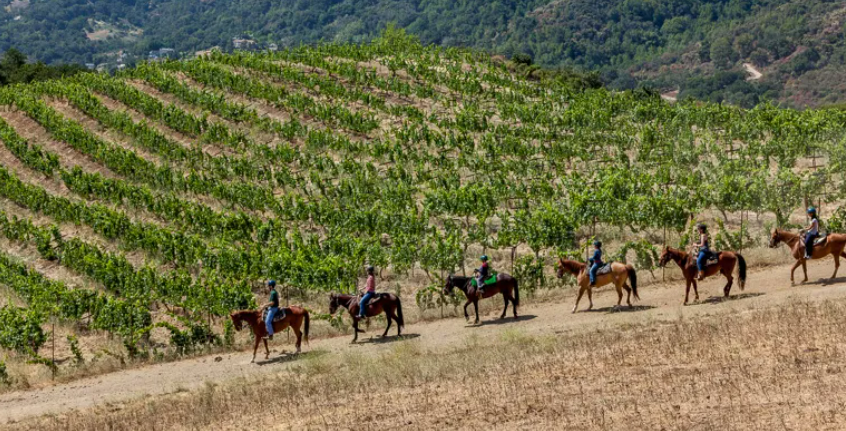Imagining a home in the city of Saratoga, the first thought that might come to mind is the picture of a suburban landscape, uniform homes with grassy backyards lined up in rows and columns.
Growing up in Saratoga, senior Ryan Caglostro has had an experience vastly different than most students: He grew up on a large ranch at the base of the Santa Cruz Mountains, being introduced to horseback riding and learning the ins and outs of winemaking. For him, the farm is not only his home, but also holds a rich history of its own.
Cagliostro is part of the Garrod family, who co-founded Garrod Farms with the Cooper family. Living close to Saratoga High School, many of Cagliostro’s siblings also attended the school, including Gianna, Sarah and Danny Cagliostro.
David Garrod founded Garrod Farms started in 1893, originally focused on farming and selling prunes and apricots, growing from 66 acres to 240 acres by 1916. Stables were opened in 1962, beginning the equestrian business while replacing the orchards. Vineyards were planted in 1972, beginning with the farming of Cabernet Sauvignon.
The ranch is now split between Garrod Farm Stables, the equestrian stables with around 50 horses, and Cooper-Garrod Vineyards, the winery split between six different vineyards, Garrod Farms spans 28 acres and has been in operation for 129 years.
“We have a team of people who work at the ranch to take care of the horses and run the winery,” Cagliostro said. “Living on the ranch has made me appreciative of everything nature has to offer.”
The winery offers wine tasting and monthly shipments of wine. A single wine bottle sells for around $45.
While all grapes are harvested once a year in the late summer and early fall, the wine making process is different for red and white wines.
For red wines, the grapes are harvested, de-stemmed and fermented with the skin’s native yeast to create the signature red color. After fermentation, the grapes are squeezed into juice and placed into barrels to age. The wine is then aged for at least a year before being bottled.
For white wines, however, grape juices are pressed first before fermentation to prevent the color of the skins coloring the wine. The juice is then fermented before getting barreled to age.
In total, about 1,800 cases of wine are produced each year with eight different varieties: Viognier, Chardonnay, Pinot Noir, Cabernet Franc, Merlot, Syrah, Cabernet Sauvignon and Petit Verdot, which is brand new and not yet on shelves. Although the wines are tart, the grapes can be individually picked and are very sweet.
In addition, Garrod Farms creates six proprietary blends named after Cagliostro’s great-uncle, George Cooper, Garrod Tasting Room and Wine Club Manager Cory Bosworth said. Cooper flew as a Test Pilot for NASA’s Ames Research Center at Moffett Field, just below San Francisco Bay.
Beyond its winemaking services, Garrod Farm Stables also allows customers to stable their horses. A stall or space in the pasture can be rented out, and clients gain access to all of Garrod Farm’s trails and horse arenas.
“About 3/4 of the horses on the property are privately owned, and the rest are ours,” Bosworth said. “The horses that Garrod Farms owns are wonderful and able to be used for both trail rides and horseback riding lessons.”
Garrod Farms also offers summer camps where people can learn how to train, ride and clean horses. People can reserve horseback riding sessions through the website and book tours around the ranch.
Living next to the ranch, Cagliostro enjoys seeing horses walk by the road and truck drivers pick grapes off the vineyards.
Cagliostro said he loves having easy access to “so much land” outside his door. He can hike up his backyard trail a couple miles for a breathtaking view.
“Growing up on a ranch encouraged me to learn equestrian vaulting for a bit,” he said. “That was my family’s thing where everyone in my family did it.”
Cagliostro has not been involved greatly in the family winemaking business, being more interested in acting or dermatology, but he occasionally helps out around the ranch when needed. His brother Danny, who majors in soil science, plans on continuing helping the family business once many of the older family members retire.
Cagliostro feels grateful for everything his family has built for themselves and other people. He appreciates how much love was put into the ranch.
“I’ve grown up there my entire life and it’s always so fun seeing other people enjoy the wine that we made and go around little tours around basically my home,” Cagliostro said.


























